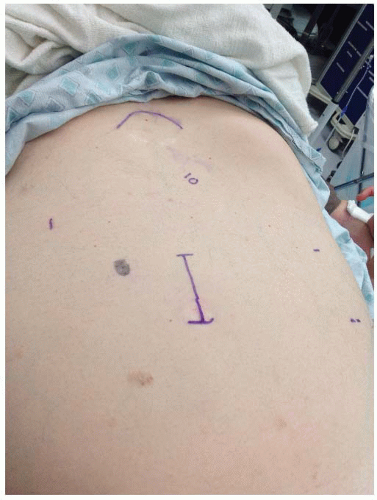Hand-Assisted Laparoscopic Right Hemicolectomy
KEY STEPS
1. Insertion of ports: 5- to 7-cm periumbilical incision for insertion of hand port; 5- to 10-mm left subxiphoid 2 cm below costal margin; 5-mm left upper quadrant; 5-mm left iliac fossa (selectively).
2. Patient rotated to the left and slightly Trendelenburg.
3. Laparoscopic assessment through the subxiphoid port.
4. Mid-transverse colon retracted toward pelvis through the hand port exposing the lesser sac.
5. Dissection through the left upper quadrant port with both monopolar and bipolar dissection.
6. Identify the duodenum at the base of the right colon mesentery.
7. Continue the dissection, separating the duodenum from the mesentery and around the hepatic flexure with blunt and energy-based dissection.
8. Continue full lateral mobilization of the right colon.
9. Cecum retracted cranially and laterally to complete mobilization of the cecum and small bowel mesentery off the retroperitoneum.
10. Confirmation of full mobilization of the right colon to the midline.
11. Division of the right branch of middle colic vessels.
12. Division of the ileocolic pedicle.
13. Exteriorization of the right colon through the gelport.
14. Standard extracorporeal resection and anastomosis.
ADDITIONAL ADVICE
1. This approach is typically observed for patients with a BMI over 40 and for those with a previous open cholecystectomy and/or bulky hepatic flexure tumor. Other patients are approached by the straight laparoscopic approach as outlined in Chapter 12.
2. When performing medial mobilization of the ileocolic artery for cancer, make your initial peritoneal incision close to the superior mesenteric artery to ensure a complete mesocolic excision.
3. When performing the medial-to-lateral mobilization of the ascending colon mesentery, draw the mesentery medially and anteriorly to stretch out the areolar attachments to facilitate and accelerate your dissection.
4. Be sure to extend your medial mobilization inferiorly behind the cecum and superiorly over the duodenum and head of pancreas right up to the lower border of the liver. Sometimes, one even opens through the hepatico-colic ligament using this approach.
5. It is often easier to leave division of the right branch of the middle colic artery until after full medial mobilization of the hepatic flexure, especially in more obese individuals.
6. When performing the superior part of the hepatic flexure mobilization, draw the colon anteriorly and inferiorly to display the space behind the hepatic flexure which has already been dissected.
7. For patients with a cancer near the hepatic flexure or transverse colon, the greater omentum is taken en bloc with the colon.
8. Mobilizing the greater omentum and transverse colon to or beyond the midline facilitates specimen extraction, particularly in more obese individuals.
9. In rare cases for extremely obese patients, a right upper quadrant port can be used. In these very obese patients, placing the “left-sided” ports through the midline makes reaching the right upper quadrant easier.
PATIENT POSITIONING
The patient is placed supine on the operating table on a bean bag. After induction of general anesthesia and insertion of an oral gastric tube and Foley catheter, the legs are placed in yellowfin stirrups. The arms are tucked at the patient’s side and the bean bag is aspirated (Fig. 13.1). For more obese patients that will not fit on the operating room (OR) table, the right arm is left out from the side. The abdomen is prepared with antiseptic solution and draped routinely.
INSTRUMENT POSITIONING
The primary monitor is placed on the right side of the patient at about the level of the shoulder. The secondary monitor is placed on the left side of the patient at the same level and is primarily for the assistant during the early phase of the operation and port insertion. The operating nurse’s instrument table is placed between the patient’s legs. The primary operating surgeon stands on the left side of the patient with the assistant standing on the patient’s right, and moving to the left side, caudad to the surgeon once ports have been inserted. A 30-degree camera lens is preferred.
HAND PORT INSERTION
A vertical incision 5 to 7 cm in length (1 cm smaller than surgeon’s glove size) starting just below the umbilicus and extending cephalad is made (Fig. 13.2). This is deepened down to the linea alba, which is then grasped on each side of the midline using Kocher clamps. Cautery is used to open the fascia between the Kocher clamps and
Kelly forceps are used to open the peritoneum bluntly. Having confirmed entry into the peritoneal cavity, the hand port is placed with a blunt port for insufflation in the center and through this site the abdomen is filled with CO2 to a pressure of 12 to 15 mmHg (Fig. 13.3).
Kelly forceps are used to open the peritoneum bluntly. Having confirmed entry into the peritoneal cavity, the hand port is placed with a blunt port for insufflation in the center and through this site the abdomen is filled with CO2 to a pressure of 12 to 15 mmHg (Fig. 13.3).
LAPAROSCOPY AND INSERTION OF REMAINING PORTS
Stay updated, free articles. Join our Telegram channel

Full access? Get Clinical Tree










